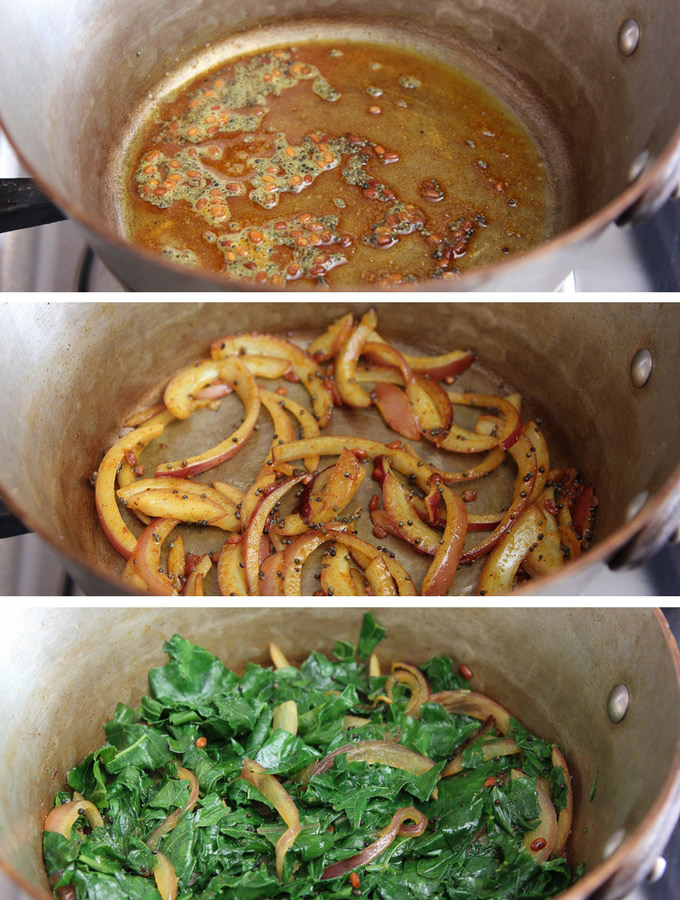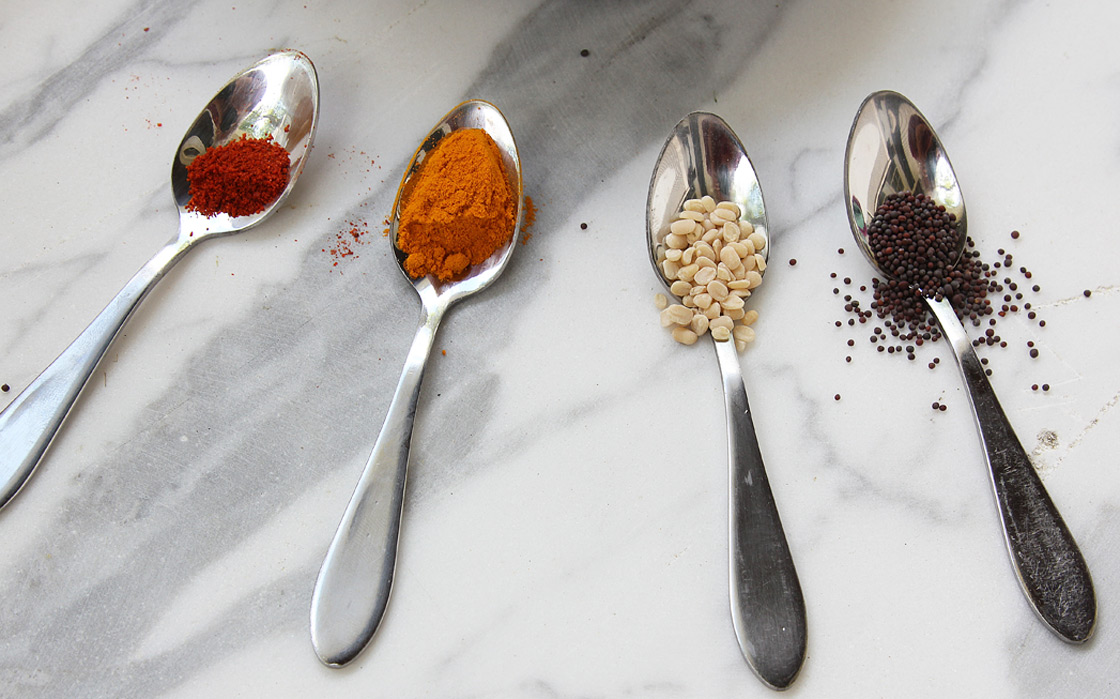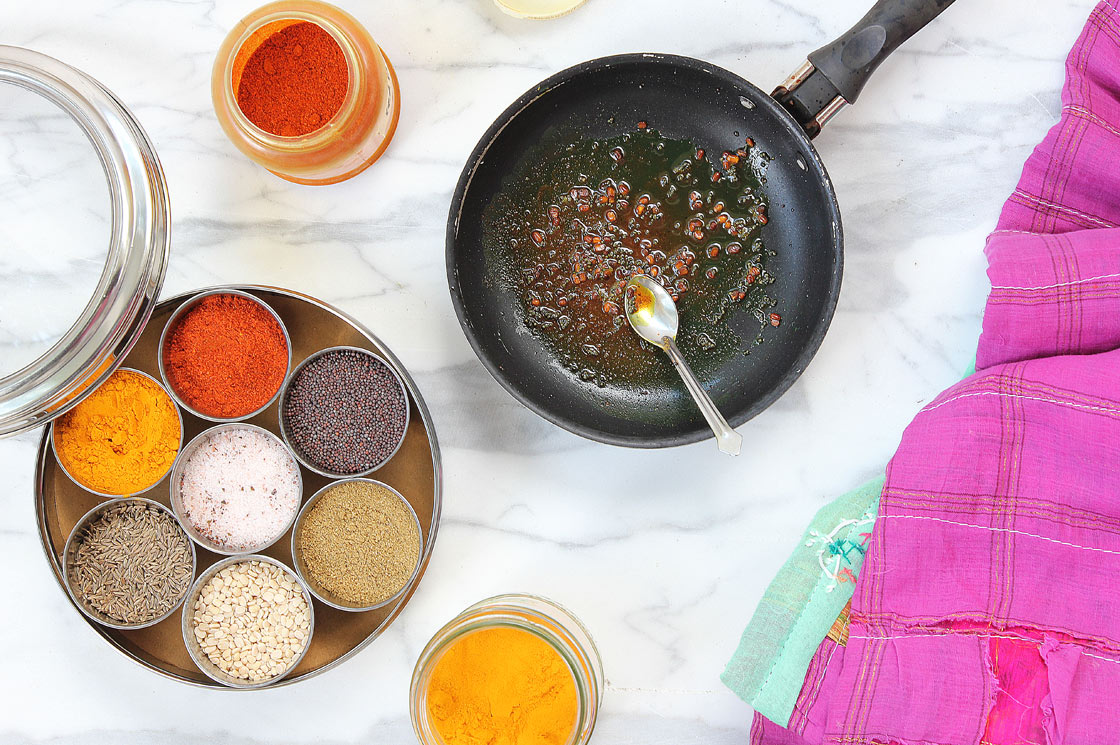South Indian seasoning is a wonderful way to prepare any vegetable. The simple spice combination enhances vegetables’ natural sweet flavors, adds nutrition, and improves digestibility.
This spice combination is the most commonly used grouping of spices in South Indian cooking.
I learned it from my mother in law, and quickly fell in love with the taste, which is flavorful, yet gentle. Best of all, I have found that this method works to prepare any vegetable.

Recipe Quick Look
Ingredients: Black mustard seeds, split urad dal, turmeric powder, red chile powder, salt, lemon juice, and 4 cups of vegetables. If you don’t have the spices, there are substitutions in the recipe below.
South Indian Preparation
Before learning how to cook vegetables South Indian style, garlic was the go-to flavoring. This is tasty, but it can be overwhelming for some people (certainly me) if consumed regularly. It is really nice to have this as an alternative.
The South Indian way to prepare any vegetable makes the most wonderful use of turmeric, which gives the vegetables a golden hue. Turmeric is also a beneficial natural anti-inflammatory, among numerous other benefits.
The black mustard seeds used in this recipe may be new to many of you. These seeds are similar to the yellow mustard seeds used for mustards, but they are also quite different.
These tiny black seeds are added to the hot oil at the beginning of cooking and sautéed until they pop. The popping transforms part of the seeds’ natural pungency into a toasty, nutty flavor.
The urad dal is also browned and becomes nutty in the hot oil. The tiny white split bean, (pictured on the third spoon above), is transformed into golden brown bits of flavor.
You also get texture from the dal, a bit of crunch. I just love this ingredient! Who imagined a lentil could be used as a spice!?As for the chili powder in this recipe, it is an Indian red chili powder, which tends to be quite hot. You can easily substitute cayenne pepper if that is all you have. The heat levels are similar.
If you need to make this dish without the urad dal and black mustard seeds, you certainly can, and you will still get good results.
My Guide to Indian Ingredient Substitutions will help you with sourcing, and in getting to know all of the wonderful spices used in Indian cooking.

Ingredients
- 1 tablespoon vegetable oil
- ½ teaspoon black mustard seeds
- ½ teaspoon split urad dal
- 1 teaspoon turmeric powder
- ½ teaspoon red chili powder (substitute with cayenne pepper)
- 4 cups vegetables, cubed or chopped, about ½-inch in size
- ½ teaspoon Himalayan pink salt
- 1 teaspoon fresh lemon or lime juice, (optional)
- 1 tablespoon fresh cilantro or coriander leaf, chopped (optional)
- 1 small onion or shallot, sliced (optional)
- * If your vegetable combo includes tomato, you have the sour flavor covered, so leave out the lemon juice.
Instructions
Method
-
Clean and chop your selected vegetables and have them ready by the stove. Keep in mind that different vegetables may take different times to cook. If you are cooking a root vegetable with a green, start cooking the roots first before adding the greens.
-
Place a 10-inch sauté pan on medium heat and add vegetable oil. When oil is hot, add mustard seeds and urad dal, and sauté until at least half the mustard seeds pop, and the dal has turned golden brown. (If you do not have these ingredients, start with the next step.)
-
Add the turmeric powder, red chili powder (or cayenne pepper), and salt to the oil for a few seconds, and stir until the aroma is released. If you are using the optional onion, sauté it in the spices now just until it starts to brown. If no onion, add the vegetables and a pinch of salt, and stir well.
-
Cover the pan and cook for 3–10 minutes (depended on the type of vegetable you are using), until the vegetables are fully cooked. Add a little water if needed to help the vegetables steam in their own juices.
-
Taste, and adjust for salt. Add a squeeze of fresh lemon or lime juice if your dish does not contain a sour vegetable. Stir in the coriander leaves if you are using it.
To serve
-
Enjoy your balanced vegetable side dish with steaming hot basmati rice. Add an Indian dal, such as Whole Mung Dal with cumin, ghee and turmeric, and Whole Wheat Roti Flatbread for a complete meal.
-
If you don’t have dal, or you would like something simpler, I would suggest enjoying the vegetables with toasted, buttered, whole wheat sourdough. Add a poached egg if you would like extra protein.






